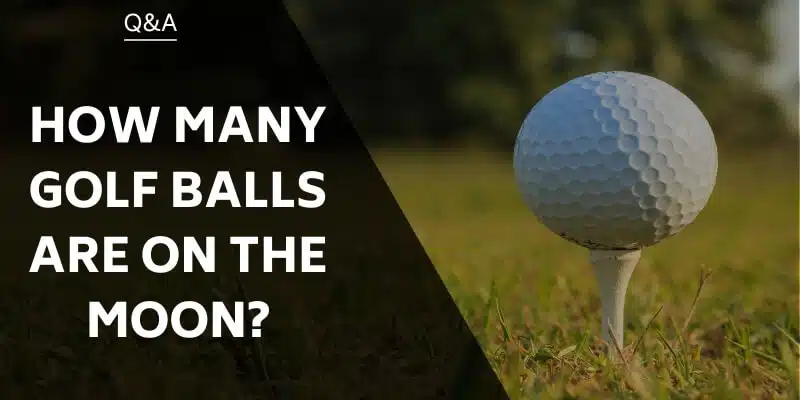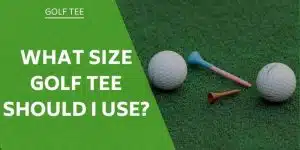If you hit your ball off the course, you’ll want to know what to do next. Let’s talk about a fundamental rule in golf called the Out of Bounds rule.
What is the golf out-of-bounds rule? In golf, a ball is out of bounds (OB) when it comes to rest outside the boundary edge of the course. White stakes or a white line typically mark this edge. If your ball goes OB, you must take a one-stroke penalty and return to the spot of your previous stroke.
Additionally, as made as an option in the 2019 Rules of Golf update, there is now a Local Rule which provides an alternative to stroke and distance relief when it is in effect. This Local Rule is recommended for casual play and not for competitions involving highly-skilled players.
Any golf fan will want to understand the rules to ensure you and your buddies stay within the rules. Read on as I will cover this additional rule and more throughout this article.
Items to be covered include:
- An Explanation Of The Out Of Bounds Rule In Golf
- The Difference Between Out Of Bounds & Lost Balls
- Explanation Of The New Out Of Bounds Local Rule Option
- Tips On How To Avoid Going Out Of Bounds
Let’s tee off! And hopefully, I can keep my breakdown of this rule within bounds!
Want more on the PGA? Learn more about Sepp Straka, winner of the Deere Classic in 2023
An Explanation Of The Out Of Bounds Rule In Golf
You must proceed under the stroke and distance rule if you hit a ball out of bounds. Before I break that down for you, let me define what out of bounds means.
What is Out of Bounds in Golf?
Out of bounds consists of all areas outside the boundaries of the course. All areas inside that boundary edge are considered in bounds.
Boundary objects or lines should define the boundary edge. Let’s look at what a boundary object and the boundary line is.
Boundary objects include:
- White stakes
- A fence
- A wall
- Roads edge
With objects such as a wall, or the curb on a road, the official rules must define that boundary edge as being out of bounds.
Boundary lines include:
- A White Painted Line on the Ground- The boundary edge, in this case, is the course-side edge of that white line. The line itself is considered out of bounds. White stakes are often used in conjunction with a white-painted line.
Weird Exceptions To The Out Of Bounds Rule?
This next part is a little nerdy, so forgive me ahead of time. The out-of-bounds edge extends both up above the ground and below the ground.
This means that all natural or artificial objects inside the boundary edge are in bounds, whether on, above, or below the ground’s surface.
Also, if an object is both inside and outside the out-of-bounds line, such as a tree, only the part of that tree that is outside the OB line is considered to be out of bounds.
Let’s say you hit a ball into the branches of a tree, and it gets stuck. The tree’s trunk is rooted out of bounds, but your ball is stuck in branches that extend in bounds. Well, you just got incredibly lucky. The ball is in bounds. Now you gotta climb that tree or impart another ruling…but that’s for another day!
How To Play Your Ball If It Goes Out Of Bounds
You only have one true option if you hit your ball out of bounds. You must go back to the spot of your previous stroke to play under the stroke and distance penalty.
- The stroke penalty means you add one extra stroke.
- The distance penalty means losing the benefit of any distance gained toward the hole from the spot where the previous stroke was made.
That means that you must hit your next shot off the tee when you re-tee.
Check this out: Golf Terms Every Golfer Must Know [Over 250 Terms!]
Using A Golf Ball Retriever To Easily Grab Your Ball
A golf ball retriever is a tool used to retrieve golf balls from difficult or inaccessible places, such as water hazards, thick rough, or under bushes. There are many different types of golf ball retrievers available, each with its own advantages and disadvantages. Some of the most common types of golf ball retrievers include:
- Suction cup retrievers: These retrievers have a suction cup at the end of a long pole. To use a suction cup retriever, simply place the suction cup over the golf ball and then pull the pole up. The suction cup will hold onto the golf ball and allow you to retrieve it.
- Stick retrievers: These retrievers have a long, thin pole with a hook or claw at the end. To use a stick retriever, simply insert the hook or claw into the golf ball and then pull the pole up. The hook or claw will grip the golf ball and allow you to retrieve it.
- Putter-mounted retrievers: These retrievers attach to the end of a putter. To use a putter-mounted retriever, simply extend the retriever and then use the putter to scoop up the golf ball.
- Throwing retrievers: These retrievers are designed to be thrown into the water or rough. Once the retriever lands near the golf ball, you can use the attached rope to retrieve the golf ball.
Golf ball retrievers can be useful for golfers who frequently lose balls in difficult or inaccessible places. They can also be helpful for golfers who have back or knee problems and find it difficult to bend over to pick up balls.
Here are some additional tips for using a golf ball retriever:
- Make sure the retriever is long enough to reach the golf ball.
- Use a firm grip on the retriever.
- Be careful not to damage the golf ball when retrieving it.
- If you are using a suction cup retriever, ensure it is clean and dry before using it.
- If you use a stick retriever, ensure the hook or claw is sharp.
- If you are using a putter-mounted retriever, make sure the retriever is securely attached to the putter.
- If you are using a throwing retriever, make sure you throw it far enough so that it lands near the golf ball.
With a little practice, you will be able to use a golf ball retriever to retrieve your lost balls quickly and easily.
The Difference Between Out Of Bounds & Lost Ball
When a golfer hits a ball out of bounds, you do not have to find it. However, in the case of a lost ball, whether presumed out of bounds or lost in bounds, you must treat that situation under the Lost Ball Rule.
What Is The Lost Ball Rule in Golf?
If you hit a wayward ball, under the rules of golf, you only have 3 minutes to find it.
A ball not found within three minutes after a search has begun is considered to be lost. A ball does not become lost due to the player declaring it to be lost; they must spend this time looking for it.
If the search for a ball happens to be temporarily interrupted for a good reason, the time between that interruption and when the search resumes does not count. The time allowed for the search is three minutes in total and does not include a reasonable interruption.
Examples of reasonable interruptions include:
- Searching stops when play is suspended for weather
- A player needs to step aside to wait for another player to play a shot
- When the player has mistakenly identified a wrong ball
The penalty for a Lost Ball is exactly the same as the Out of Bounds rule. That is stroke, distance, and a reply of the shot from its original spot.
If you think a ball may be lost, it is advised to hit a Provisional Ball from your original spot. This will save you time from returning to that spot if your ball is indeed determined to be lost.
Exception To The Lost Ball Rule
In terms of a Lost Ball, there are some exceptions. A ball is not considered lost if it flew into a penalty area, so long as all playing agree that it did indeed go into that designated area. If that happens, you will proceed under the rule for either a red or yellow-marked penalty area.
What Is A Penalty Area in Golf?
A Penalty Area is defined as:
Any body of water on the course, including:
- The ocean
- A lake
- A pond
- A river
- A ditch
- A surface drainage ditch
Even if there is no water in these areas, but it is marked as a penalty area, you would proceed under the rules for either a red or yellow marked penalty area.
Read on: The Best Golf Ball Retrievers
What Is The New Out Of Bounds Local Rule for 2019?
In 2019, the USGA and R&A introduced a new local rule allowing players to drop a ball in the fairway when it goes out of bounds.
To use the rule, players must first estimate the spot where their ball went out of bounds. They can then drop a ball within two club lengths of the nearest point on the fairway that is not closer to the hole than the estimated spot. The player must then take a two-stroke penalty.
One of the biggest reasons this new option was brought into the fold was to help speed up non-competitive, recreational play. This local rule is not for competitions involving highly-skilled players.
More from Golf Span: Golf Slang 101: Master the Lingo of the Game
Tips To Play a Ball That Is Out of Bounds
- If you think your ball might be out of bounds, consider playing a provisional ball. This is a second ball that you can hit in case your first ball goes out of bounds. If your first ball is out of bounds, you can then drop the provisional ball and continue playing without returning to the spot of your previous stroke.
- If you are playing a provisional ball, you must announce that you are doing so before you hit the ball. This is important because it lets other players know that you are not giving up on your first ball.
- If you find your original ball in bounds within three minutes, you can continue playing with that ball. However, if you do not find your original ball within three minutes, you must abandon it and play the provisional ball.
- If you are playing in a tournament, be sure to check the local rules. Some tournaments may have different rules for playing balls that are out of bounds.
- Do not try to find your ball if it is clearly out of bounds. This will only waste time, and you will still have to take a one-stroke penalty.
A great read: What is a Mulligan in Golf? Golfing Terms Explained for Everyone
FAQ
How Many Strokes is a Lost Ball?
A lost ball in golf is a one-stroke penalty, and you must play the original ball or another ball from the place of your previous ball.
Where Do You Drop if You Hit Out of Bounds?
Yes and no. If you are playing by the proper rules of golf, no, you must proceed under the stroke and distance penalty. However, if you play under the updated, more casual Local Rule introduced in 2019, you can drop where your ball went. The penalty is two strokes.
Can You Play From Out of Bounds in Golf?
No, you can not play a ball from out of bounds. In most cases, out-of-bounds are no longer golf course property and may be private property. Please do not hit your ball out of someone's yard!
Final Thoughts
Aw, the rules of golf, love them or hate them; if you play this game, you have to, at a minimum, respect them. Most golfers do indeed want to do what is right by the rules. Unfortunately, the rules are not generally taught when someone first learns how to play. That is a shame in my eyes, and I do all I can to help educate golfers on the game’s rules. That includes how to handle the Out of Bounds rule.
Basically, if your ball goes OB, you must take a stroke and return to where you hit your previous shot.
Hopefully, this article helped you understand this rule and how to proceed under it.
Until next time…keep it in the fairway!
Brendon is Class A PGA Professional and founded Little Linksters, LLC, and its nonprofit arm, the Little Linksters Association for Junior Golf Development. He won 25+ prestigious industry honors, including the 2017 PGA National Youth Player Development Award. He graduated from the PGA of America Management Program and has a handicap index of 7.8.
He has played golf for over 40 years and currently plays twice a month at the Eagle Dunes Golf Club near Sorrento, Florida. He loves Srixon clubs and plays a ZX5 driver with Z 585 irons. He's written over 60 articles on GolfSpan and specializes in sharing tips to improve your golf game. You can connect with Brendon at LinkedIn, X, IG, FB, his website, or BrendonElliott@pga.com.
- Best score: 69
- Favorite driver: Srixon ZX5
- Favorite ball: Srixon Z Star
- Favorite food at the turn: Turkey and cheese on white











